
7 Ways LLM AI Transforms Business Communication Efficiency
GeneralKey Highlights:
- Agentics provides tailored voice AI solutions that enhance business communication through advanced voice recognition and natural language processing.
- 81% of the public believes organisations should prioritise AI assurance policies, indicating AI’s importance in business.
- 57% of respondents expect AI to improve job performance, showcasing the value of Agentics’ solutions for workplace efficiency.
- LLM AI automates client interactions, leading to faster response times and improved customer satisfaction.
- Yum! Brands plans to implement AI-driven voice-ordering technology across 500 locations by mid-2025, highlighting the trend towards automation.
- AI-driven translation tools are essential for real-time language translation, enhancing global business communication.
- Companies using sentiment analysis can refine communication strategies based on client emotions, boosting engagement and loyalty.
- LLM AI enhances CRM systems, allowing businesses to personalise customer experiences and meet evolving consumer expectations.
- Automating routine tasks with LLM AI can reduce administrative time by up to 30%, improving internal communication.
- AI-driven chatbots and virtual assistants improve customer service by providing immediate responses and reducing contact centre labour costs.
Introduction
In a world where effective communication is paramount, businesses face the challenge of enhancing their interactions in increasingly innovative ways. As organisations turn to tailored voice AI solutions and the groundbreaking capabilities of large language models (LLMs), they uncover new methods to streamline communication, automate customer interactions, and personalise experiences.
The rising demand for seamless global communication underscores the urgency of this transformation; AI-driven tools are dismantling language barriers and providing real-time insights into customer sentiments. This article delves into the transformative impact of these technologies on business communication, illustrating not only how they improve efficiency but also how they foster stronger relationships with customers.
As the landscape of communication evolves rapidly, understanding and adapting to these advancements is essential for organisations aiming to thrive in today’s competitive marketplace.
Agentics: Tailored Voice AI Solutions for Enhanced Business Communication
Agentics stands at the forefront of delivering tailored voice llm ai solutions that dramatically enhance business interactions. By harnessing cutting-edge voice recognition and natural language processing technologies, including llm ai, the agency optimises both internal and external communication processes. Their accessible and scalable solutions are meticulously customised to meet the diverse needs of various sectors, empowering organisations to leverage llm ai effectively to enhance interaction metrics and boost customer engagement.
Notably, 81% of the public believes that organisations should prioritise the development of AI assurance policies, highlighting the growing recognition of AI’s crucial role in modern business practises. Furthermore, a recent Ipsos AI Monitor survey indicates that 57% of respondents anticipate AI will enhance their job performance, reinforcing the significance of Agentics’ solutions in driving workplace efficiency.
This bespoke approach not only addresses the complexities of traditional communication methods but also enables organisations to achieve measurable improvements in efficiency and satisfaction.
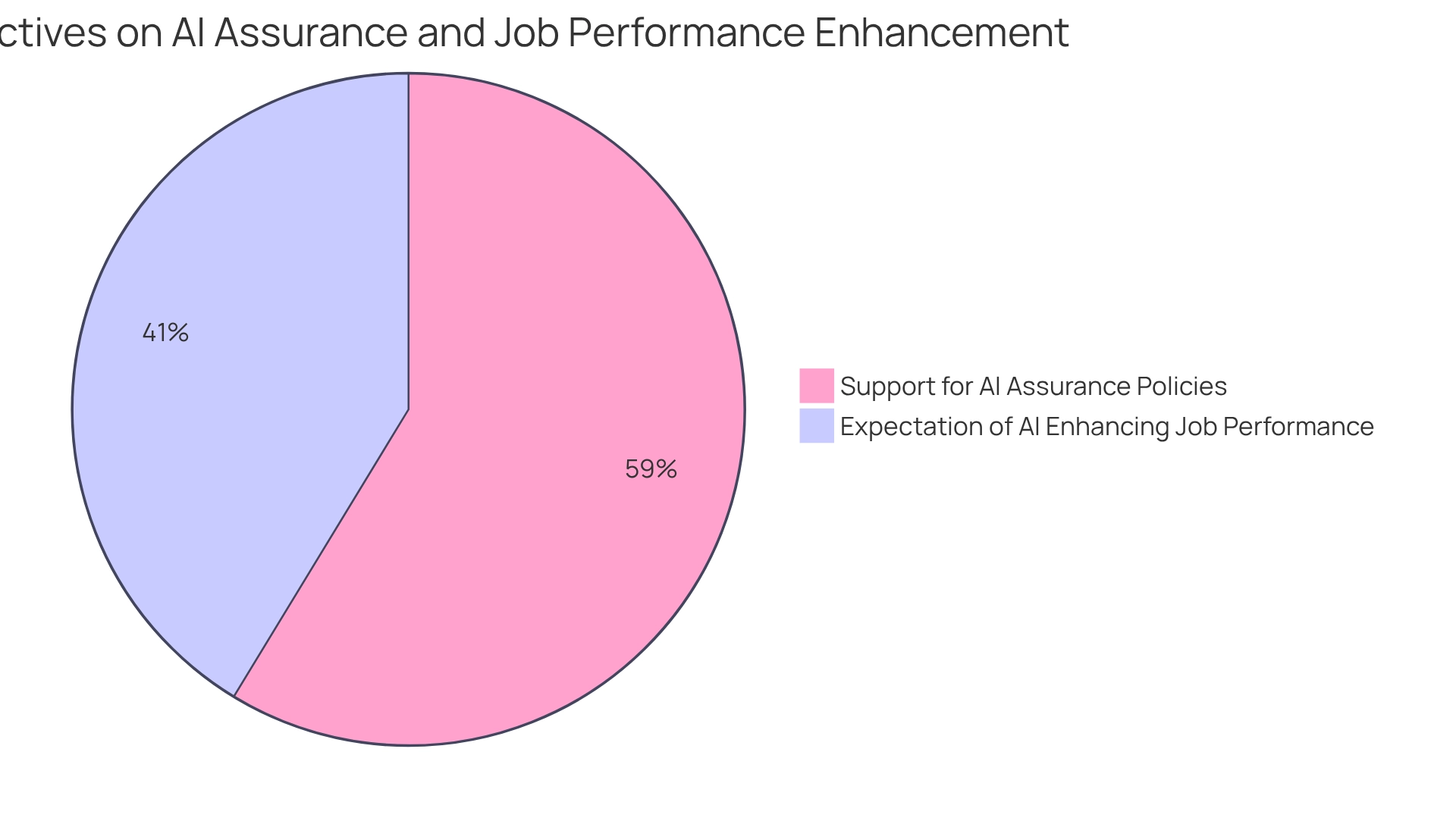
Automate Customer Interactions with Large Language Models
LLM AI is revolutionising client interactions by generating human-like responses to enquiries, allowing businesses to manage a significantly higher volume of client queries without the need for additional personnel. This automation leads to faster response times and enhanced client satisfaction. For instance, large language models can be seamlessly integrated into chatbots, offering 24/7 support that ensures clients receive timely assistance at any hour.
Recent advancements underscore the growing adoption of LLM AI in client support. Yum! Brands, for example, plans to deploy AI-driven voice-ordering technology across 500 locations by mid-2025, illustrating the trend towards automating client interactions.
The benefits of LLM AI extend beyond mere efficiency; they also contribute to improved client satisfaction metrics. Research indicates that organisations utilising LLM AI for service automation have experienced notable increases in their Customer Satisfaction Scores (CSAT) and Net Promoter Scores (NPS), which are critical indicators of loyalty and service quality. These metrics provide valuable insights into client behaviour and assist in predicting future interactions, highlighting the importance of LLM AI in modern business communication strategies.
Experts in the field emphasise that the effective use of LLM AI not only streamlines processes but also enhances the overall client experience. As Madhuri Gourav points out, poor service can lead to higher acquisition costs, as companies must continually seek new clients to replace those lost due to dissatisfaction. By leveraging LLM AI, businesses can mitigate these risks and foster stronger client relationships.
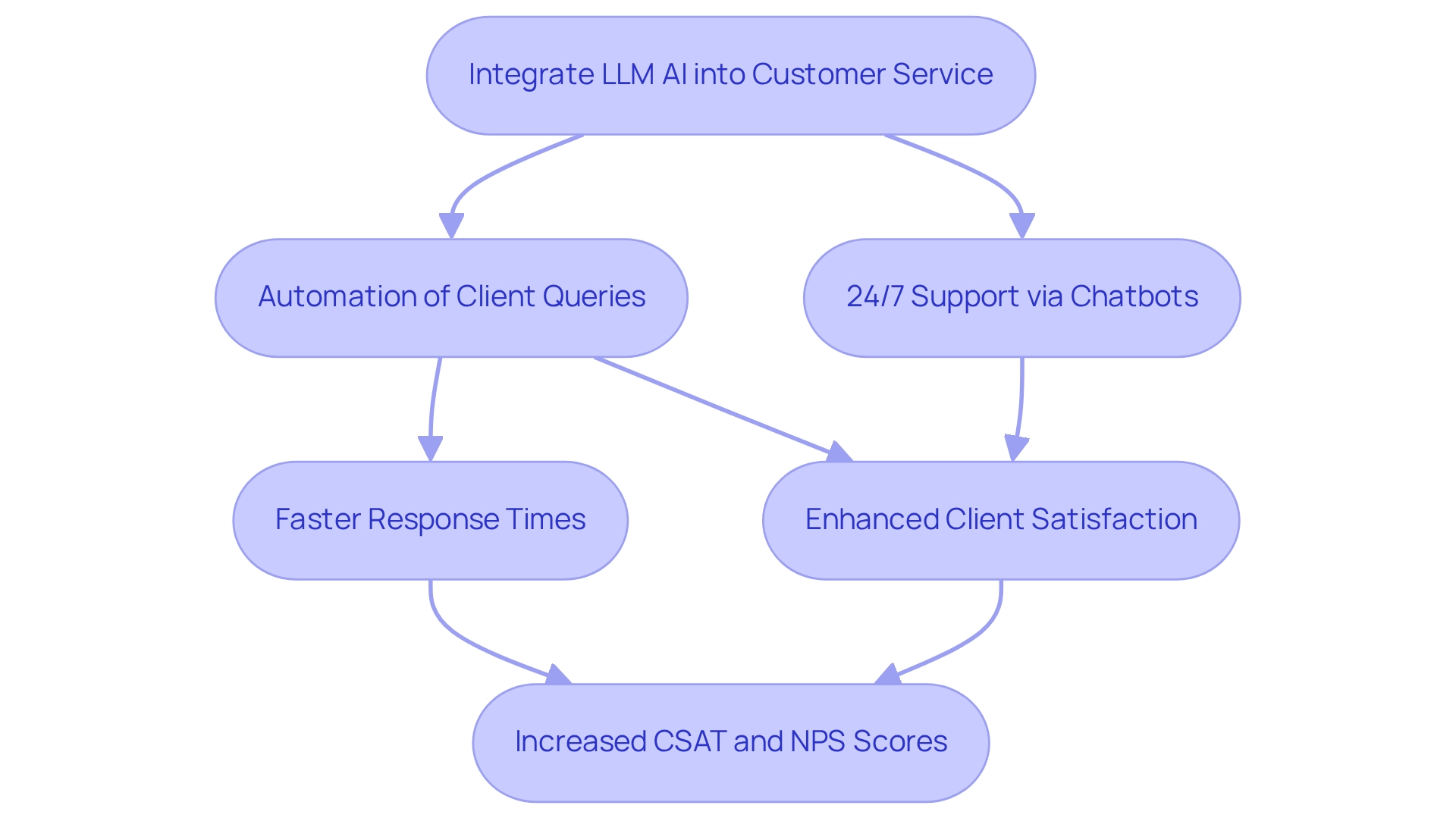
Enhance Global Communication through Real-Time Language Translation
Enhance Global Communication through Real-Time Language Translation
Real-time language translation powered by large language models (LLMs) is revolutionising how businesses communicate with clients and partners across the globe. By breaking down language barriers, organisations foster seamless interactions that enhance collaboration and elevate service quality. For instance, Agentics’ customised voice AI solutions leverage AI-driven translation tools during video conferences and support engagements, facilitating immediate understanding and response—an essential capability in today’s interconnected marketplace.
Current trends reveal a surging demand for swift and precise translations, with AI translation tools playing a crucial role in fulfilling these requirements. By 2025, advancements in real-time language translation are expected to further enhance business interactions, empowering companies to operate more efficiently on a global scale. Statistics show that organisations utilising these tools experience improved interaction metrics, leading to heightened client satisfaction and engagement.
Experts affirm the effectiveness of AI-driven translation tools, with linguistics specialists noting their ability to maintain context and nuance—critical elements for successful communication. Companies across various sectors are already reaping the benefits; for example, organisations employing Agentics’ AI translation for customer support report faster response times and improved customer retention rates.
The impact of AI translation tools on global communication is significant, with projections suggesting that AI-powered translation could contribute up to $15.7 trillion to the global economy by 2030. This growth is associated with enhanced communication capabilities that enable enterprises to connect with broader audiences and engage more effectively in diverse markets. As LLM AI continues to evolve, its role in enhancing global business communication will become increasingly vital.
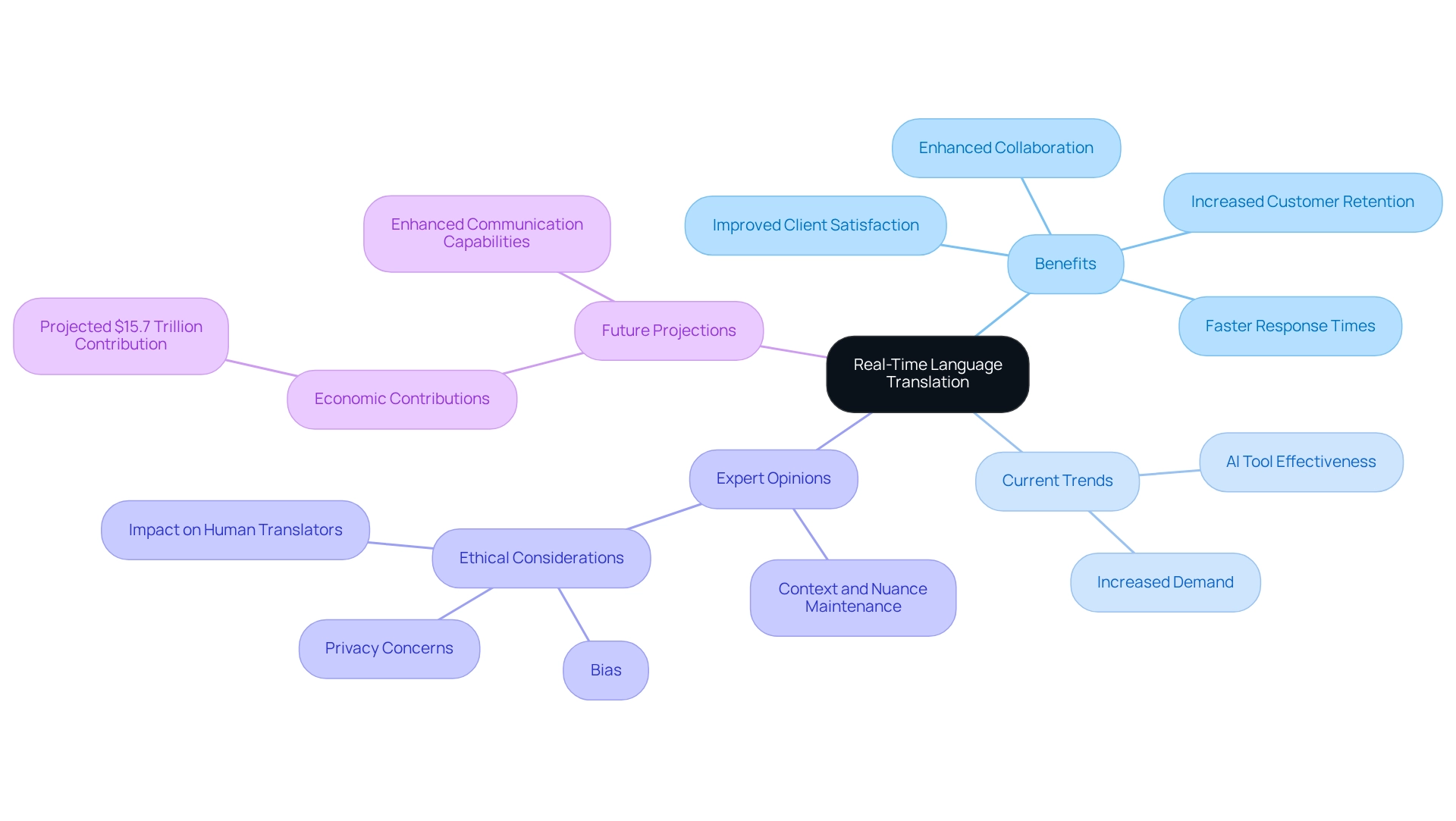
Leverage Data Analysis for Actionable Insights from Customer Feedback
Utilising LLM AI empowers companies to analyse vast amounts of feedback data, extracting actionable insights that drive strategic decisions. By employing advanced natural language processing techniques, organisations can identify trends, sentiments, and critical areas for improvement. This data-driven approach enables companies to align their strategies with consumer preferences and pain points, ultimately fostering enhanced satisfaction and loyalty. For instance, AI tools can efficiently categorise feedback into distinct themes, allowing teams to prioritise product development and service enhancements based on genuine user needs.
However, a significant challenge persists, as only 34% of service agents fully grasp their department’s AI strategy. This underscores the urgent need for improved understanding and integration of AI insights into business operations. Furthermore, industry leaders emphasise the importance of connecting data insights with human experiences to elevate service delivery and engagement, reinforcing the value of actionable insights derived from feedback analysis.
Recent findings reveal that the Azure versions of GPT-3.5 and GPT-4 outshine their OpenAI counterparts in both accuracy and speed, showcasing the formidable capabilities of LLM AI in data analysis. Moreover, qualitative information from users is often overlooked, yet it is vital for grasping client needs. To effectively harness these insights, businesses must ensure their teams are well-trained in AI strategies and motivated to incorporate customer feedback into their decision-making processes.
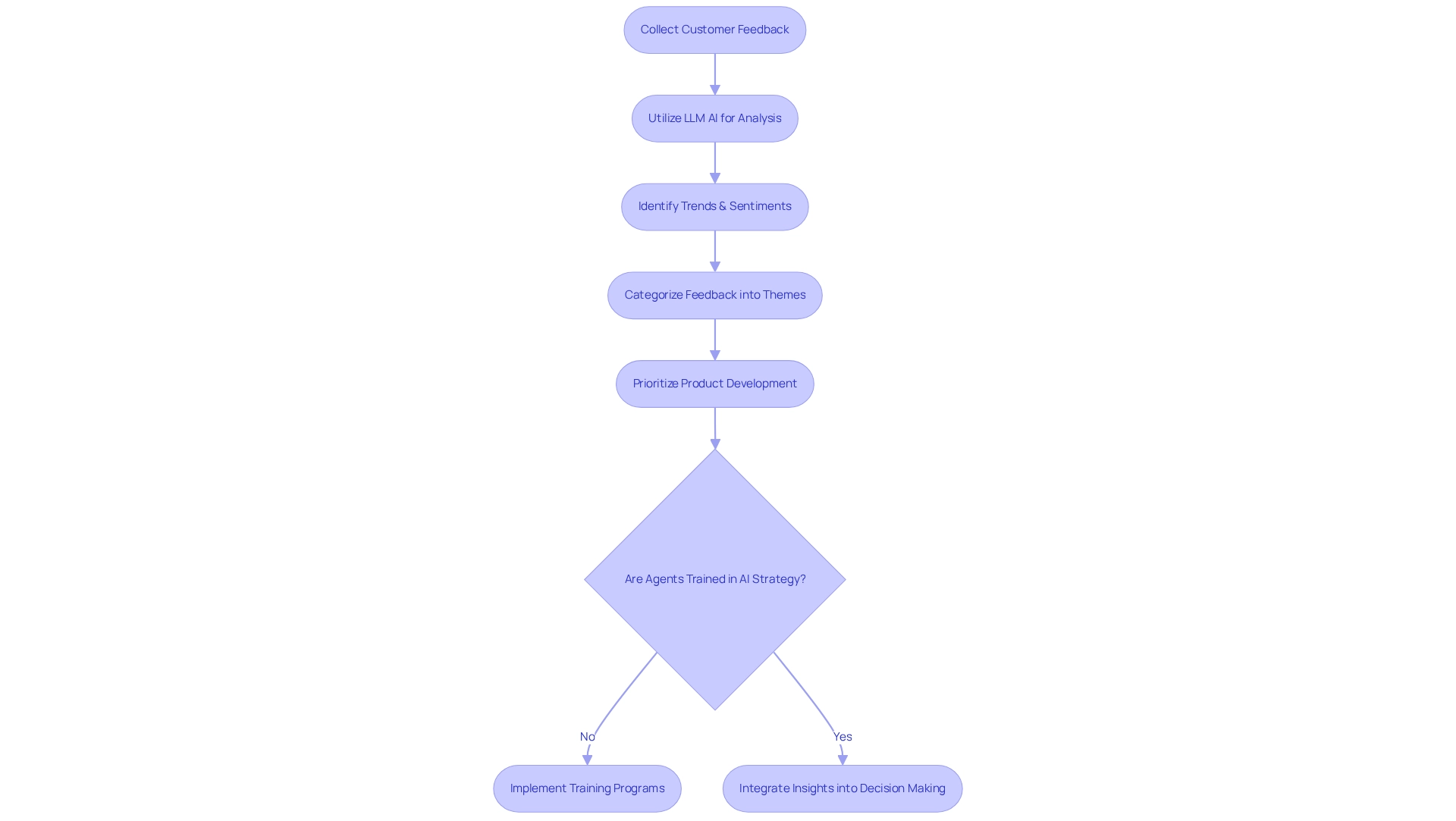
Streamline Internal Communications by Automating Routine Tasks
Automating routine tasks such as scheduling meetings, sending reminders, and managing approvals significantly enhances internal interactions. LLM AI is particularly adept at managing these repetitive functions, allowing employees to focus on more strategic initiatives.
For example, Agentics’ AI-driven tools can automatically generate meeting agendas based on prior discussions, ensuring comprehensive coverage of relevant topics without the need for manual input. This not only saves valuable time but also reduces the risk of miscommunication.
In fact, studies reveal that organisations utilising LLM AI for automation can achieve up to a 30% reduction in time spent on administrative tasks, thereby enhancing productivity and efficiency. As organisations increasingly embrace AI technologies, the potential for streamlined workflows and improved communication becomes tangible, positioning firms to excel in a competitive landscape.
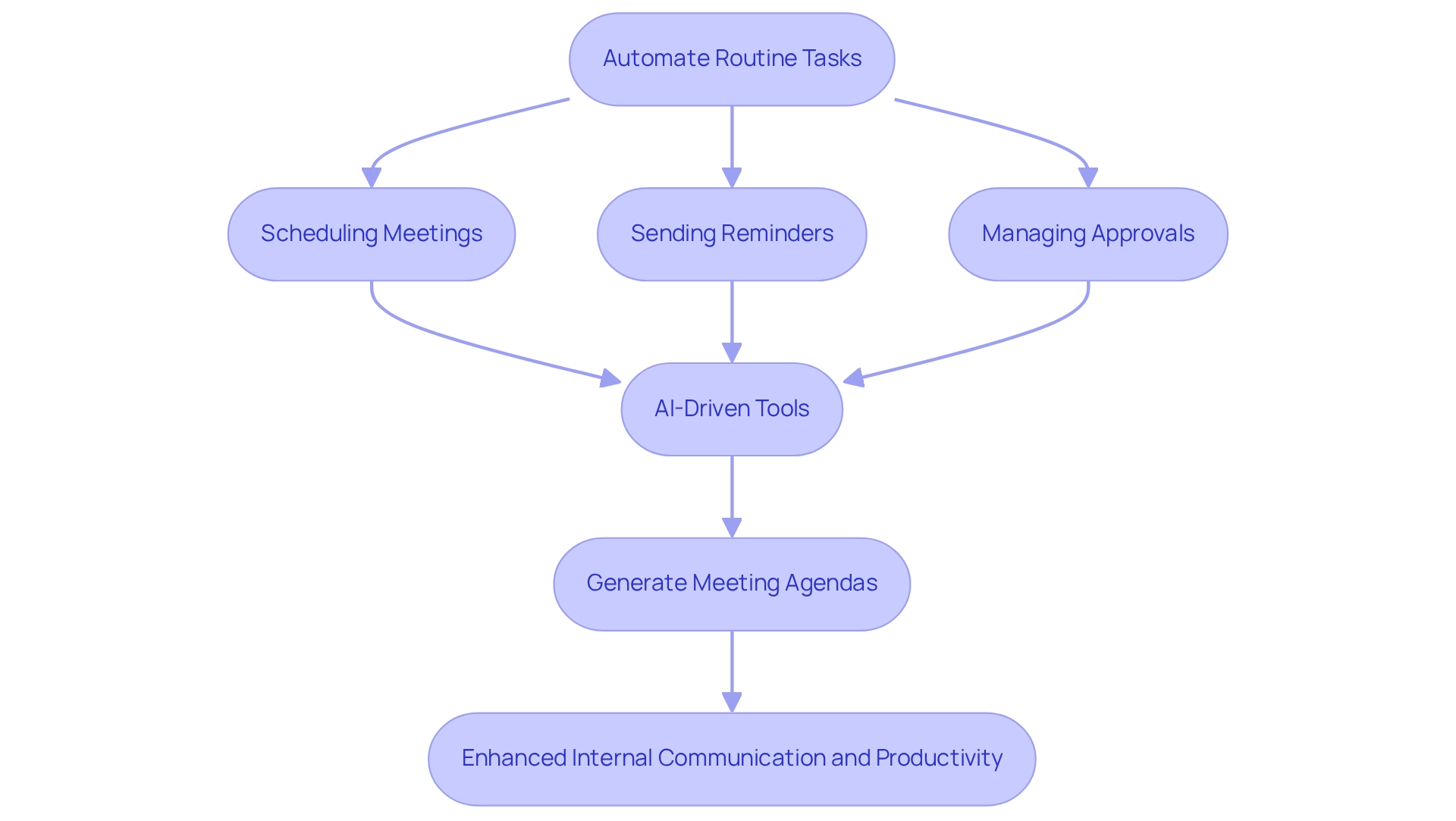
Personalize Customer Experiences with LLM-Enhanced CRM Systems
LLM AI-enhanced Customer Relationship Management (CRM) systems are revolutionising the way businesses analyse client data to create personalised experiences. By leveraging advanced algorithms, these systems can discern client preferences and behaviours, enabling the delivery of tailored recommendations that significantly elevate engagement and satisfaction. For instance, an AI-driven CRM can autonomously generate customised marketing messages based on a client’s prior interactions, ensuring that communications are not only relevant but also timely.
Statistics reveal that 69% of clients expect consistent experiences across both physical and digital channels, underscoring the imperative for businesses to adopt such technologies. Moreover, organisations are increasingly recognising the transformative potential of llm ai in marketing and sales, with reports indicating that its adoption has more than doubled in recent years. This trend is further validated by case studies illustrating how AI voice agents have revolutionised service operations, resulting in enhanced interactions and streamlined processes.
As companies endeavour to cultivate client loyalty and lifetime value, the integration of CRM systems enhanced by LLM AI becomes indispensable. By providing clear insights into the utilisation of client data, businesses can lay a robust foundation for successful personalisation initiatives. Looking ahead to 2025, the emphasis on tailored client experiences through llm ai-driven CRM tools is projected to intensify, with organisations harnessing these systems to meet evolving consumer expectations and maintain a competitive edge in the marketplace.
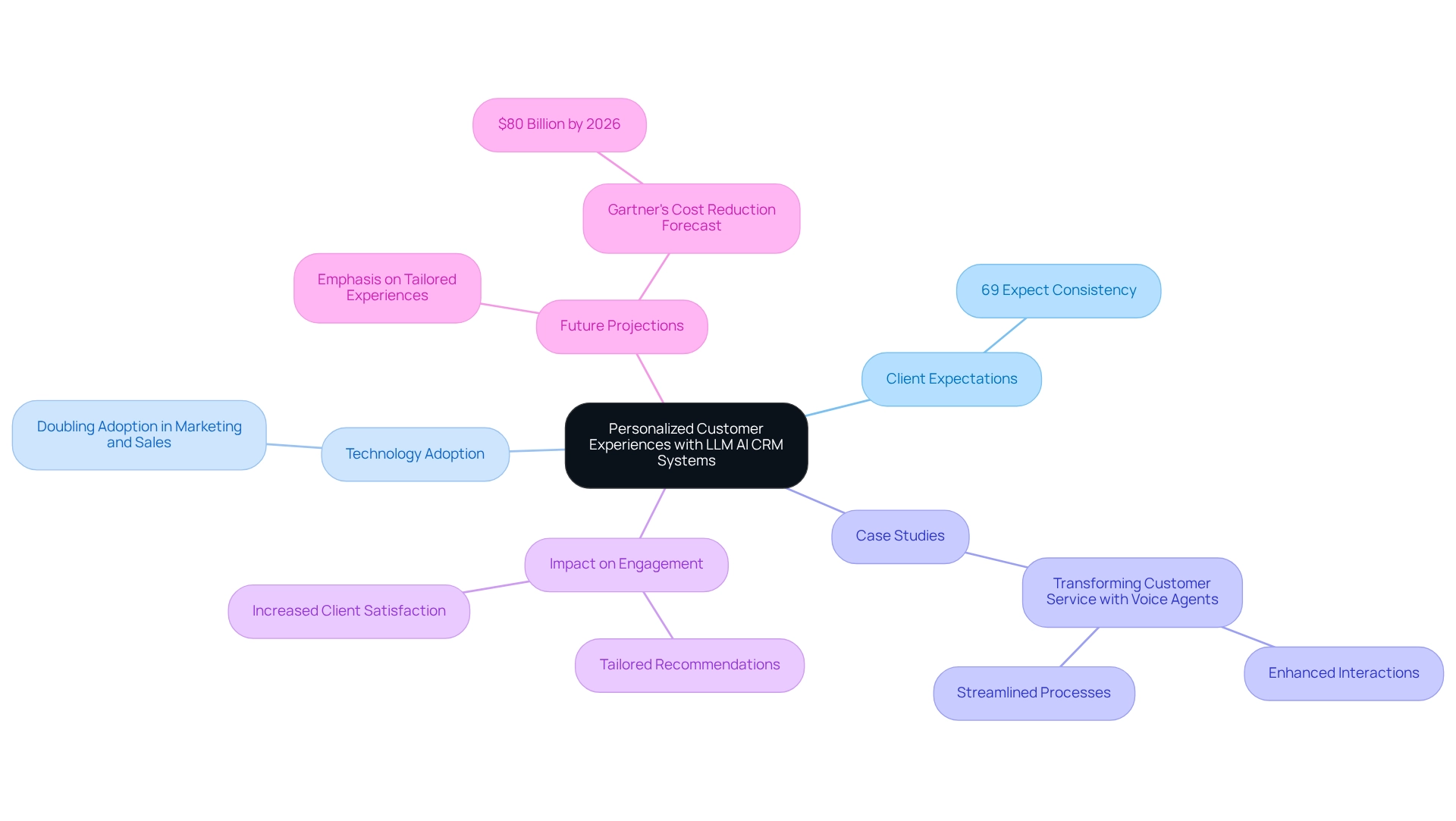
Facilitate Training and Onboarding with Instant Information Access
AI technologies significantly enhance training and onboarding by providing immediate access to essential information and resources. This capability addresses a pressing challenge: the need for efficient and effective onboarding processes.
Utilising llm ai as virtual assistants enables employees to obtain immediate responses to their inquiries and support through training modules. This instant access accelerates the acclimation process for new hires, alleviating the workload on HR teams.
For instance, AI-powered onboarding platforms can create personalised learning paths tailored to an employee’s specific role and prior experience, facilitating a smoother transition into the organisation. Notably, organisations utilising such technologies report that onboarding processes are completed 53% faster, with new hires becoming productive 40% sooner.
However, 68% of organisations struggle to personalise onboarding at scale, underscoring the critical need for AI solutions that track progress and provide real-time feedback. As Sourav Aggarwal notes, ‘Companies complete onboarding 53% faster, new hires become productive 40% sooner, and employee satisfaction scores increase significantly.’
By integrating these advanced systems, companies can foster a more engaging onboarding experience that not only boosts productivity but also enhances employee satisfaction. The evidence is clear: adopting llm ai solutions is not just beneficial—it’s essential for modern organisations aiming to optimise their onboarding processes.
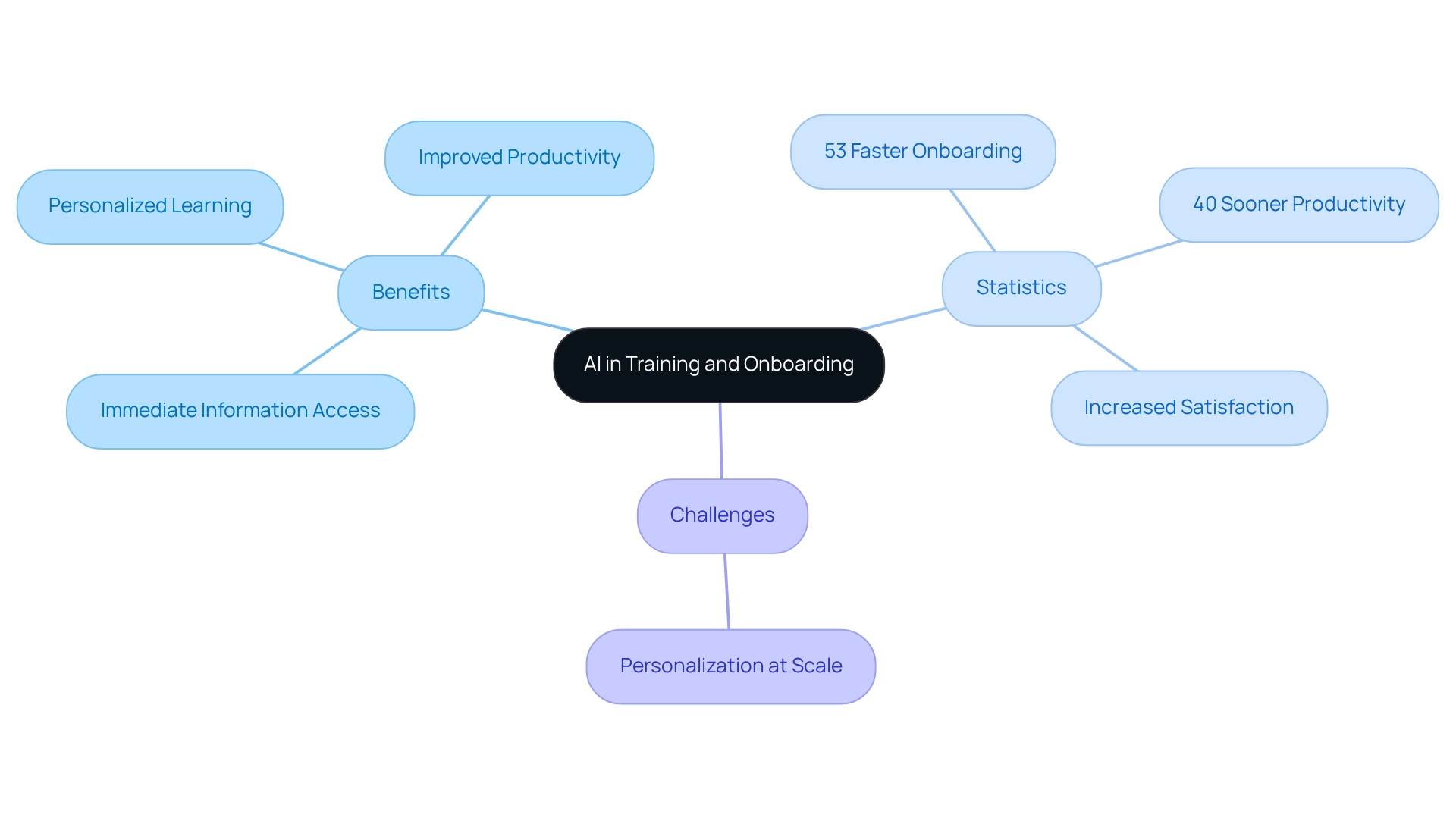
Utilize Sentiment Analysis for Tailored Communication Strategies
Sentiment analysis powered by llm ai enables enterprises to accurately assess client emotions and opinions across diverse interaction channels. By thoroughly analysing feedback, social media engagements, and service dialogues, organisations can refine their communication strategies to align with client sentiments. For instance, when sentiment analysis reveals negative perceptions about a product, businesses can take proactive measures—such as targeted messaging or product enhancements—to effectively address these issues.
Current trends indicate that companies leveraging sentiment analysis witness significant improvements in client engagement and satisfaction. Statistics reveal that organisations that actively respond to client feedback can boost loyalty and retention rates. As Ford Blakely asserts, “How an individual perceives their interactions or experiences with you is their reality.” This underscores the importance of understanding client sentiment for tailoring messages that meet their needs. Furthermore, as George R. Bach notes, demonstrating care in every client interaction fosters loyalty and repeat patronage, further emphasising the critical role of sentiment analysis in crafting impactful messaging strategies.
By 2025, companies are increasingly adopting sentiment analysis to enhance their messaging strategies. Case studies illustrate how organisations have successfully utilised sentiment analysis to improve client relations, resulting in superior operational outcomes. By aligning messaging strategies with client sentiment, businesses can not only elevate satisfaction but also drive overall enterprise success. Remember, “Your most dissatisfied clients are your greatest source of learning,” highlighting the necessity for companies to identify and address their communication challenges over time.
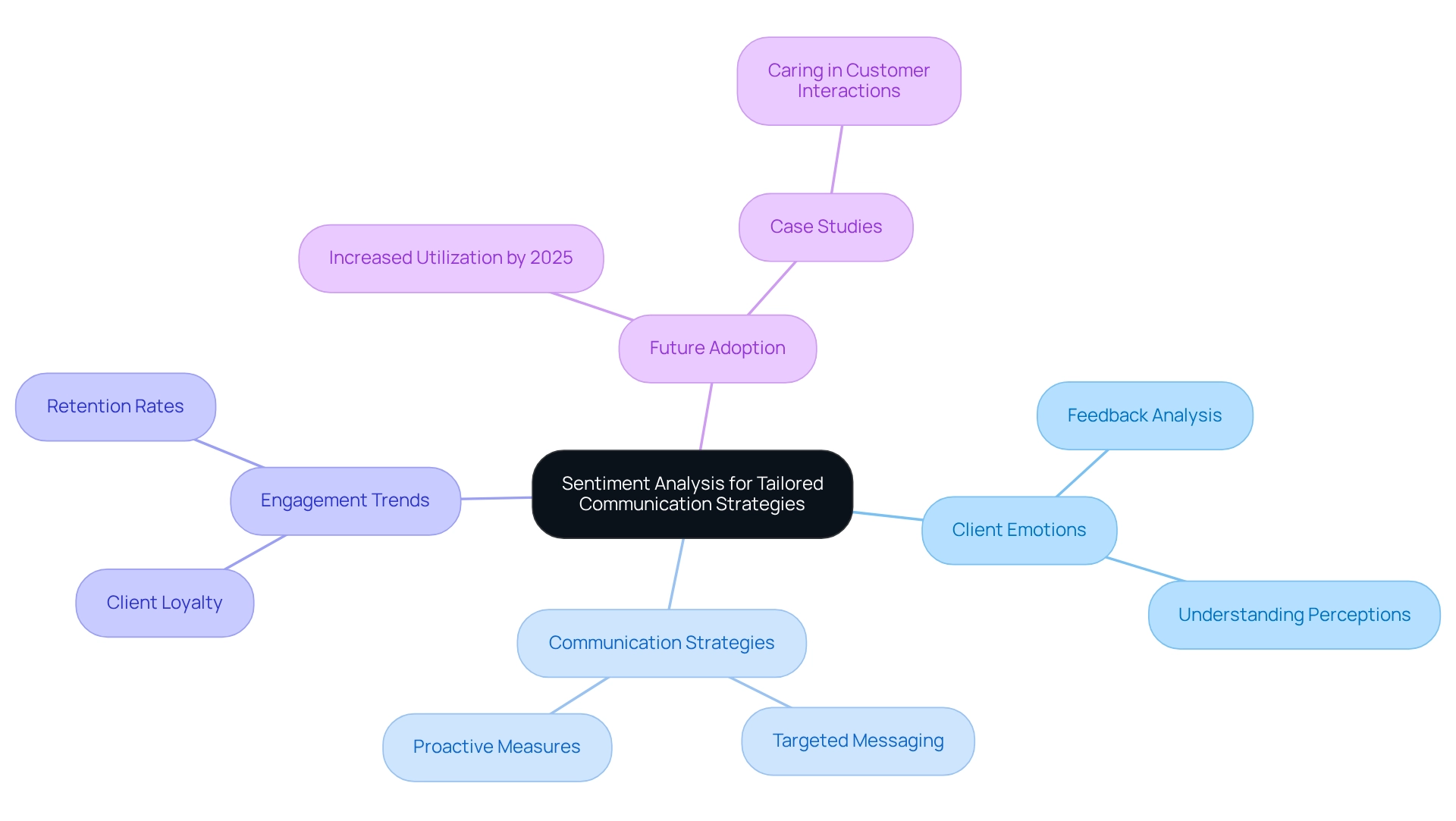
Generate Targeted Marketing Content with LLM Capabilities
Large language models (LLMs), often referred to as llm ai, excel at creating targeted marketing content by leveraging consumer data and analysing market trends. This advanced capability empowers businesses to craft personalised campaigns that resonate deeply with their audience.
For instance, llm ai can generate personalised email marketing messages tailored to individual preferences and behaviours, significantly boosting engagement and conversion rates. Furthermore, AI optimises content across various platforms, ensuring consistent and effective messaging.
In fact, studies indicate that AI tools can respond to client inquiries up to 90% faster than traditional methods, thereby enhancing overall communication efficiency. According to SurveyMonkey, 50% of marketers foresee performance expectations increasing, underscoring the growing reliance on llm ai in their marketing strategies.
Additionally, a case study titled “AI’s Effect on Response Times” illustrates that AI tools can analyse data and automate replies, achieving response times that are up to 90% faster than manual processes. As businesses increasingly adopt these technologies, the potential for enhanced client satisfaction and streamlined marketing efforts becomes abundantly clear.
Embrace the power of AI solutions to elevate your marketing strategies and drive meaningful results.
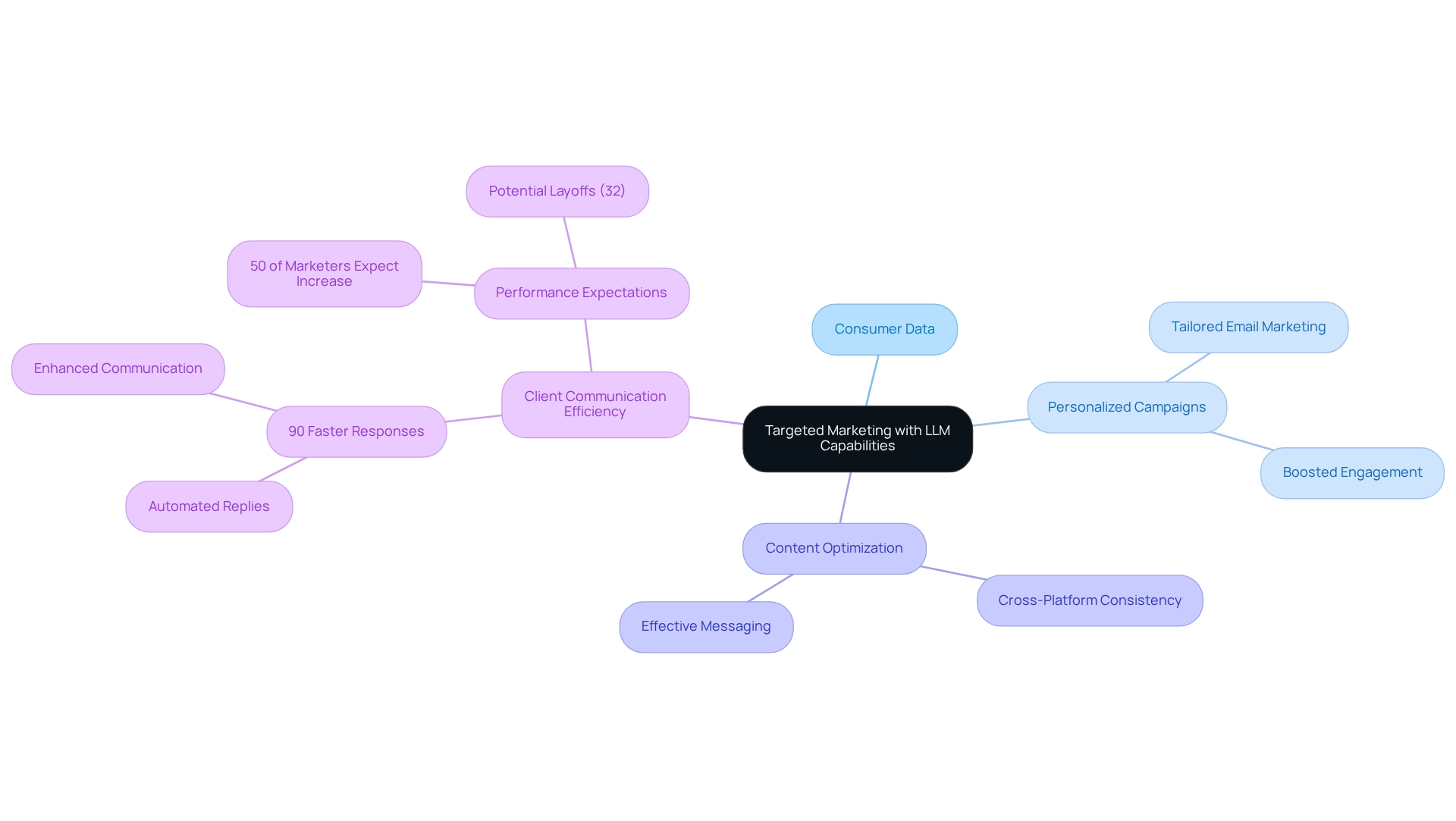
Improve Customer Service with LLM-Driven Chatbots and Virtual Assistants
LLM AI-driven chatbots and virtual assistants are revolutionising service interactions by providing immediate and precise responses to inquiries. These advanced AI tools utilise natural language processing to engage in meaningful conversations, enabling them to tackle complex queries, furnish detailed product information, and assist with troubleshooting. As they learn from each interaction, their capacity to respond effectively continues to enhance, culminating in heightened client satisfaction.
The advantages of implementing chatbots that utilise LLM AI are substantial. Businesses that deploy these AI solutions have reported a significant decrease in response times and an uptick in client engagement. For instance, organisations that have adopted AI-driven service strategies, including emotion recognition and personalised interactions, have witnessed a 30% increase in customer loyalty. Furthermore, Gartner forecasts that by 2026, conversational AI will contribute to reducing contact centre labour costs by $80 billion, underscoring the financial benefits of these technologies.
Despite the potential, only 25% of call centres have successfully integrated AI automation into their daily operations, signalling a considerable opportunity for businesses to enhance their service capabilities. As chatbots powered by LLM AI continue to evolve, they are poised to play a pivotal role in shaping the future of customer support, making it more efficient and responsive to customer needs.
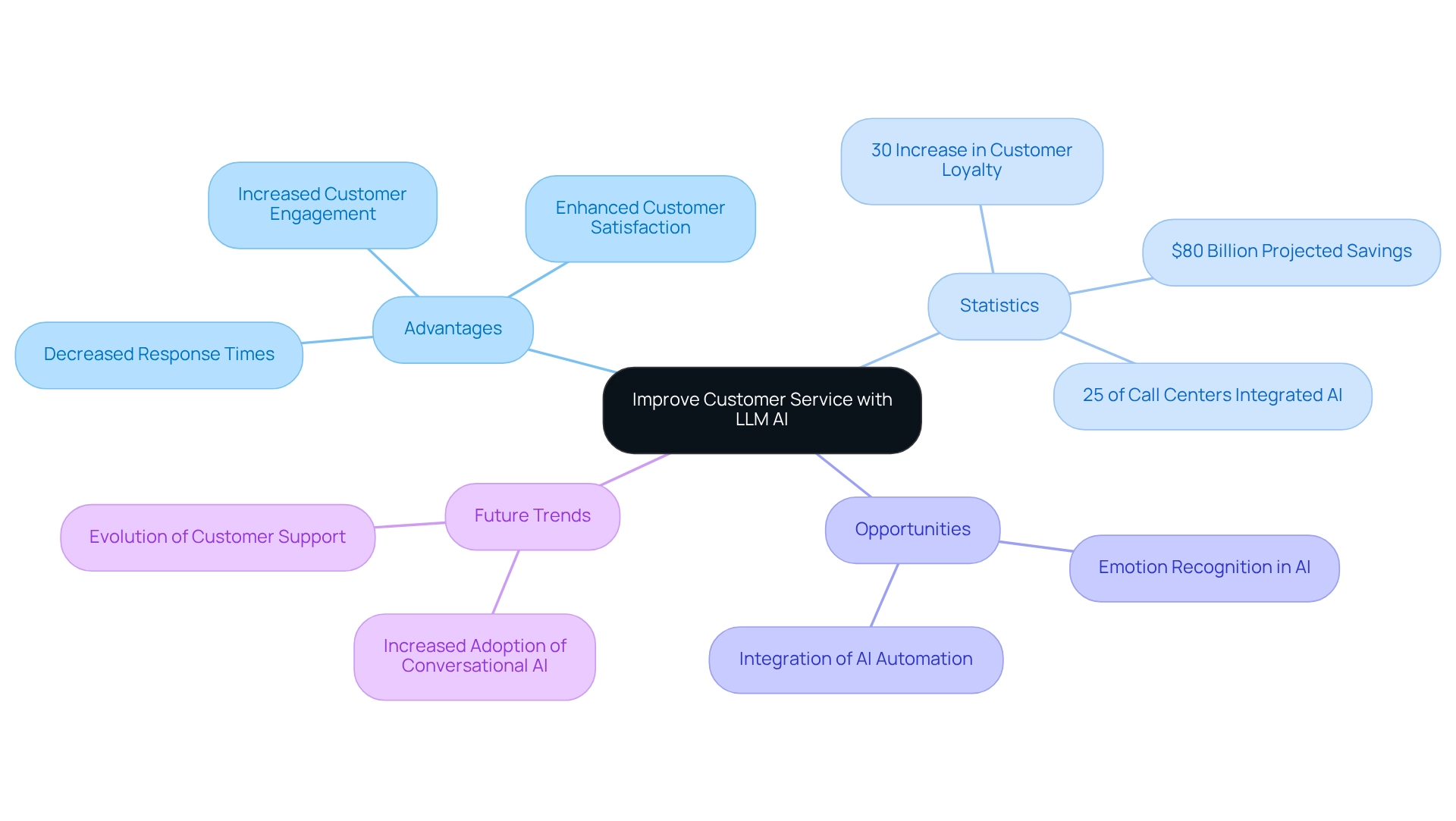
Conclusion
The transformative impact of voice AI solutions and large language models on business communication is undeniable. By leveraging these advanced technologies, organisations can streamline internal and external communication, automate customer interactions, and enhance personalised experiences. Companies like Agentics are leading the way in delivering tailored voice AI solutions that significantly improve communication metrics and foster stronger customer engagement.
The benefits of LLMs in customer service automation are particularly noteworthy. They empower businesses to manage a higher volume of inquiries while ensuring faster response times and increased customer satisfaction. Real-time language translation tools further break down barriers, enabling seamless global communication and collaboration. Moreover, actionable insights derived from customer feedback analysis empower organisations to make data-driven decisions that align with customer preferences, ultimately enhancing loyalty and satisfaction.
As businesses continue to adopt AI-driven tools, the potential for improved efficiency, streamlined operations, and enriched customer experiences becomes increasingly apparent. By embracing these advancements, organisations can enhance their communication strategies and position themselves for success in a competitive marketplace. The integration of AI technologies is not merely a trend; it is a crucial step toward establishing stronger relationships with customers and achieving long-term business growth.
Frequently Asked Questions
What is Agentics and what services do they offer?
Agentics provides tailored voice AI solutions that enhance business communication by utilising advanced voice recognition and natural language processing technologies, including large language models (LLM AI). Their solutions are customised to meet the diverse needs of various sectors, optimising both internal and external communication processes.
How does LLM AI improve customer interactions?
LLM AI revolutionises client interactions by generating human-like responses to inquiries, allowing businesses to manage a higher volume of client queries without additional personnel. This leads to faster response times and improved client satisfaction, with applications such as chatbots providing 24/7 support.
What are the benefits of using LLM AI in customer service?
Organisations using LLM AI for service automation have reported increases in Customer Satisfaction Scores (CSAT) and Net Promoter Scores (NPS), indicating improved loyalty and service quality. LLM AI streamlines processes and enhances the overall client experience, reducing acquisition costs associated with poor service.
How does real-time language translation impact global communication?
Real-time language translation powered by LLMs allows businesses to communicate seamlessly with clients and partners worldwide, breaking down language barriers. This enhances collaboration and service quality, with AI-driven translation tools facilitating immediate understanding during interactions.
What are the expected trends in AI translation tools by 2025?
By 2025, advancements in real-time language translation are anticipated to further enhance business interactions, enabling companies to operate more efficiently on a global scale. Organisations utilising these tools are expected to see improved interaction metrics and heightened client satisfaction.
What is the projected economic impact of AI-powered translation by 2030?
AI-powered translation is projected to contribute up to $15.7 trillion to the global economy by 2030, driven by enhanced communication capabilities that allow enterprises to connect with broader audiences and engage effectively in diverse markets.
Enjoyed this post? Share it with your network!
10 Best AI Sales Tools to Boost Your Team’s Performance

Discover the top 10 best AI sales tools to enhance team performance and drive revenue growth.
Mastering Test Call Numbers: A Step-by-Step Guide for Sales Directors

Elevate your communication with our guide on mastering test call numbers for sales success.
7 Ways Automated Outbound Calls Boost Sales Performance

Discover how automated outbound calls enhance sales performance and streamline communication.
